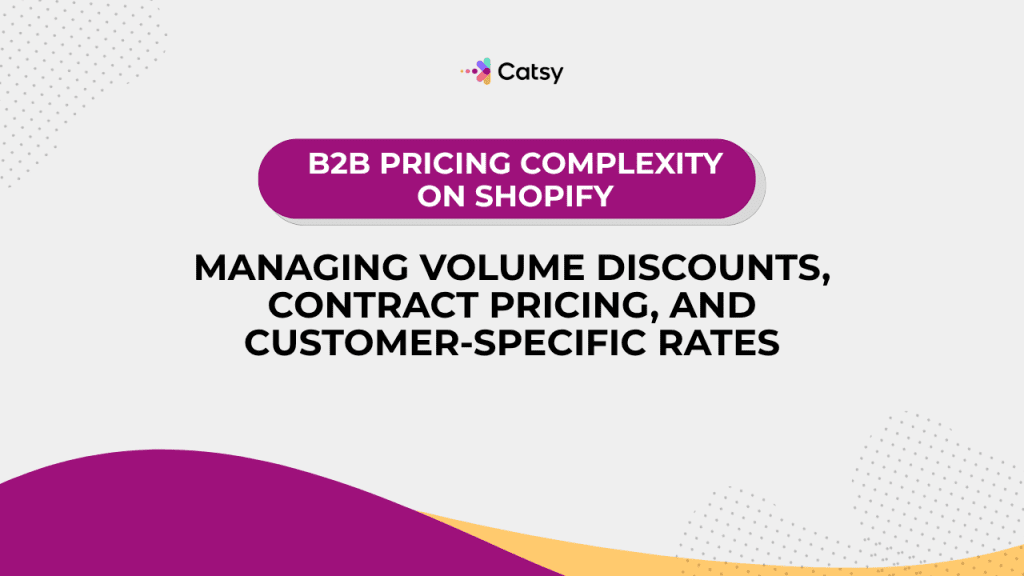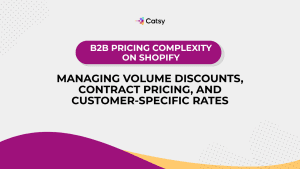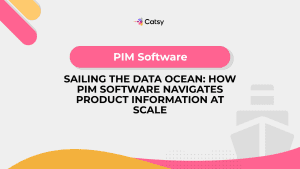B2B Pricing Complexity on Shopify: Managing Volume Discounts, Contract Pricing, and Customer-Specific Rates
B2B companies that leverage Shopify’s platform know that pricing complexity management can be challenging! Unlike business-to-consumer retail with straightforward pricing, business-to-business relationships are intricate and specific to the customer.

Chart Your Pricing Course
What You’ll Learn:
- Strategic approaches to complex B2B pricing implementation on Shopify
- Technical solutions for volume discounts and tiered pricing structures
- Contract pricing management that scales with business growth
- Customer-specific rate systems that maintain operational efficiency
In this Article
B2B Pricing on Shopify: Charting Strategic Waters
B2B companies that leverage Shopify’s platform know that pricing complexity management can be challenging! Unlike business-to-consumer retail with straightforward pricing, business-to-business relationships are intricate and specific to the customer.
What is B2B Pricing Complexity?
B2B pricing complexity encompasses the multifaceted pricing requirements of B2B companies. This includes volume-based discounts, negotiated contracts, and customer-specific pricing agreements. Regional pricing variations and dynamic pricing adjustments must also be considered.
Of course, this challenge intensifies when you consider that B2B customers expect a seamless digital experience. The shopping journey should emulate that of retail, but with pricing logic that reflects complex business relationships.
Traditional e-commerce platforms often struggle with these requirements, forcing businesses to choose between simplified pricing models or complex workarounds that create operational headwinds.
Why Advanced Pricing Management Has Become Essential for Charting B2B Success
Business-to-business buyer expectations have evolved, and that’s changed how your pricing should be presented and managed. Today’s procurement professionals expect self-service options and real-time pricing. Streamlined ordering processes that reflect your buyer’s commitments is imperative.
When you implement sophisticated pricing management systems, you enable your sales teams to, well, sell. Your employees can focus on building relationships while your PIM does the heavy lifting – organizing your data, accelerating ordering processes, and providing your customers with ideal customer experiences.
The integration of advanced pricing logic with modern B2B platforms has become crucial for maintaining competitive bearing. Companies that can provide immediate, accurate pricing will gain significant advantages in customer satisfaction and operational efficiency compared to your competitors who are relying on manual pricing processes.
Make Catsy DAM and PIM Software an Extension of Your Team
Book a Free DemoVolume Discount Architecture: Setting Your Pricing Coordinates
Many industrial brands and mid-sized manufacturers either don’t use PLM at all or use it improperly. But there’s a price for ignoring it. When PLM practices are fragmented, manual, or team-specific, it affects your entire product ecosystem.
This can lead to fragmented product knowledge, launch delays and bottlenecks, compliance issues, increased return rates, and agitated personnel in the real world.
Tiered Discount Structures:
Effective volume discount systems must be flexible. You may need to handle multiple discount tiers based on quantity ranges, or specific breaks across product categories.Order values may also contribute to the application of discounts.
Your systems need to calculate discounts dynamically while providing clear visibility to customers about potential savings from increased order quantities.
Progressive vs. All-Units Pricing:
Business-to-business pricing often involves decisions between progressive discount structures (that’s where only quantities above a threshold receive discounted rates) and all-units pricing (where reaching a threshold applies discounts to the entire order). Each approach requires different technical implementation and customer communication strategies.
Category-Specific Volume Rules:
Your business may apply different volume discount structures across product categories. Implementation should accommodate these variations while still providing transparency and accuracy.
Seasonal and Promotional Integration:
Volume discount systems should coordinate with seasonal pricing adjustments. Promotional campaigns and special offers should also be supported without calculation errors. This requires robust rule engines that can handle these appropriately.
Contract Pricing Management: Navigating Agreed Waters
Negotiated Rate Storage and Retrieval:
To implement contract pricing, you need secure storage of information that’s specific to each customer. Appropriate access controls and audit capabilities are also essential. Your system must be able to retrieve and apply these rates, and should have built-in safeguards for products that are not covered by specific agreements.
Contract Term Management:
Effective contract pricing systems track contract validity periods, renewal dates, and quantity commitments. A robust PIM includes automatic notifications for approaching renewals and systems for managing pricing transitions between contract periods.
Approval Workflow Integration:
In many cases, contract pricing scenarios require approval workflows to cover exceptions and special requests. These workflows should integrate with your legacy processes while maintaining efficiency.
Performance Tracking and Analytics:
Your PIM should support contract renewal negotiations and pricing optimization. That means tracking contract utilization, volume commitment information, and analysis of pricing performance.
Customer-Specific Rate Implementation: Charting Individual Courses
Account-Based Pricing Hierarchies:
If you use customer-specific pricing, you know that this pricing model involves complex hierarchies. Your rules may cascade from parent accounts to departments or subsidiaries. Your PIM should handle these relationships while providing transparency and control.
Integration with Customer Relationship Systems:
To implement customer-specific pricing, you need tight integration with your CRM and ERP systems. This ensures that pricing reflects information about credit terms, account standing, and more. Real-time accuracy is essential.
Geographic and Shipping Considerations:
If you’re expanding, your PIM should be able to accommodate. Shipping destinations, delivery methods, and regional cost structures should be accounted for in your pricing structures. A product information management system can do the work for you – automatically.
Exception Handling and Override Capabilities:
Even the most sophisticated automated pricing systems require exception handling capabilities for unique situations. Implementation must balance automation with flexibility for special circumstances while maintaining appropriate controls and audit trails.
PIM/DAM Solutions for Navigating Complex B2B Pricing
Integrated Product and Pricing Data Management:
PIM + DAM (Digital Asset Management) platforms provide the foundation for sophisticated pricing. They centralize your data and pricing relationships while maintaining customer-specific information.
Catsy PIM/DAM as a Comprehensive Navigation Solution:
Catsy stands out in the PIM + DAM space for its handling of complex business-to-business scenarios. Multi-tiered pricing structures, customer-specific catalogs, and contract-based pricing are all scenarios you may encounter. Our platform enables businesses to maintain centralized control over product information while supporting dynamic pricing requirements.
Advanced Pricing Rule Integration:
A modern PIM + DAM solution like Catsy can integrate pricing logic with your product data management. This enables more sophisticated rules that will include your product attributes, customer segments, contracts, and other considerations. This will eliminate data files that can complicate your B2B pricing.
Scalable Data Architecture:
A PIM + DAM platform provides you with scalability. Your PIM can support everything from volume discounts to complex matrices. A solid platform can easily handle this complexity while maintaining performance and accuracy.
Top 4 Technical Solutions for Charting Shopify B2B Pricing Waters
- Advanced App Integration Strategy:
Shopify has native pricing capabilities, but they may require enhancement. Third-party apps and custom code are often used. Choose solutions that easily integrate with Shopify’s checkout process but still provide the complex business-to-business pricing your customers require.
Consider platforms like Catsy PIM/DAM that can manage complex product data and pricing relationships alongside content management requirements.
- API-First Pricing Architecture:
Develop pricing systems that leverage Shopify’s API capabilities! Calculate prices dynamically based on customer identity, or based on contractual terms. This enables real-time accuracy but still maintains system performance.
- Customer Segmentation and Tagging Systems:
Use Shopify’s tagging and grouping features to implement robust customer segmentation. This foundation enables sophisticated pricing rules while keeping you efficient.
- Integrated ERP Connectivity:
Shopify and your ERP systems should seamlessly connect to ensure consistency everywhere your customers find you. Your integration should handle real-time updates, contract terms, and customer account sync… without disrupting your order processing workflows.
Real-World B2B Pricing Implementation Success Stories
Industrial Supply Chain Transformation
A complex industrial supplier served customers with widely varying pricing agreements. These were based on volume commitments, geographic regions, and specific product categories.
Implementing Shopify created customer-centric pricing portals – automatically. Contracted rates were displayed to the consumer while providing clear volume discount visibility. This reduced pricing errors and also accelerated order processing.
Manufacturing Component Distributor Innovation
A distributor of precision components served OEM manufacturers used dynamic pricing that reflected real-time inventory levels, customer volume commitments, and seasonal demand patterns.
Their solution allowed for immediate pricing feedback to customers. Profitability was maintained due to intelligent pricing optimization which accounts for multiple variables.
Chemical Products B2B Platform
A specialty chemical company created a sophisticated pricing system that handled hazmat surcharges, regulatory compliance costs, and packaging requirements.
With PIM, total landed costs are calculated – including all fees and surcharges – while maintaining transparent pricing communications with customers.
These implementations demonstrate that sophisticated B2B pricing systems can enhance both customer experience and operational efficiency when designed thoughtfully and implemented correctly.
Working with B2B Pricing Implementation Navigators
To implement complex B2B pricing on Shopify, you need expertise that spans e-commerce technology, business processes, and integration architecture.
The technical complexity of pricing rule engines, combined with the need for seamless integration with existing business systems, often exceeds internal development capabilities.
Implementation specialists, however, understand the nuances of B2B pricing requirements – they can recommend proven approaches to balance function and maintenance. Experience with edge cases, performance optimization, and ongoing maintenance requirements are critical.
As you’re evaluating potential partners, seek specialists with demonstrated experience in these areas. The right partner provides not just initial implementation but strategic guidance on charting your pricing strategy as business requirements change and grow.
Key Takeaways
- B2B pricing complexity requires sophisticated technical solutions that extend beyond Shopify’s native capabilities
- Success depends on seamless integration between pricing systems and existing business processes
- Volume discounts, contract pricing, and customer-specific rates each require distinct technical approaches and implementation considerations
- Effective solutions balance automated efficiency with flexibility for complex business relationships
- Professional implementation expertise is often essential for managing technical complexity and ensuring long-term success
Want more tips, tutorials, and insights on product content and e-commerce operations?
Stay connected. We post regularly to help brands like yours scale smarter.
Are You Ready To streamline your product content management?

Frequently Asked Questions
Shopify is flexible, thanks to its extensive API capabilities and app ecosystem. Success requires combining Shopify’s core platform with custom integrations, specialized apps, and external systems.
The key is designing architecture that leverages Shopify’s strengths while addressing its B2B limitations.
Multi-dimensional pricing requires hierarchical rule engines that can process multiple variables at the same time. An effective approach involves customer segmentation combined with product categorization and quantity-based calculations.
To implement this, you’ll usually need to use external pricing engines in conjunction with Shopify. This will allow you to handle complex computations without disrupting the customer experience.
Pricing accuracy requires robust data management. Automated validation systems and integration with authoritative contract management are imperative.
Key strategies may include centralized contract storage, automated price updates, exception reporting for unusual pricing scenarios, and regular audits to make sure that your contractual agreements are honored.
Slow and steady wins the race. Begin with high-impact pricing scenarios, then expand systematically. Start with volume discounts, for example, then add contract pricing for major accounts. Finally, implement customer-specific rates. A phased approach allows your teams to learn and adapt while minimizing the risk of business disruption.
Subscribe For More Content
Sign up for monthly tips on how to drive revenue with product content.




